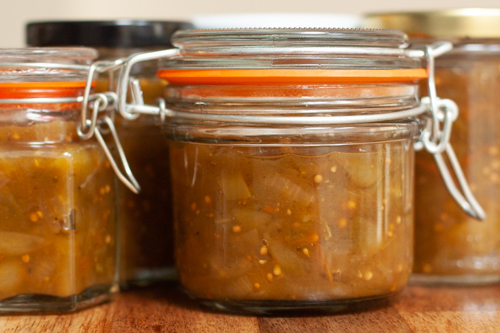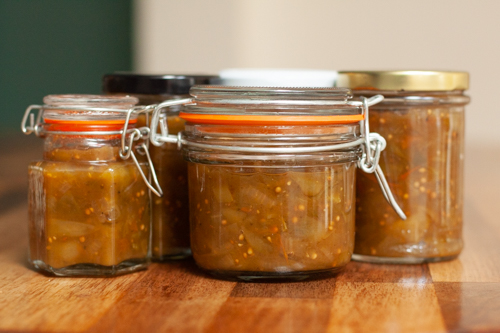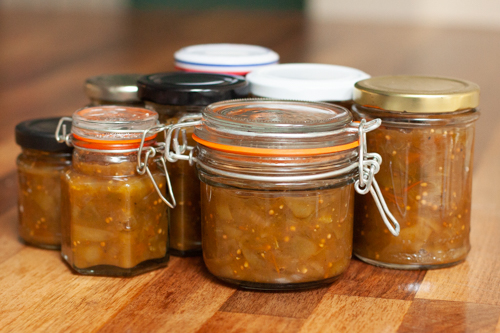Green tomato chutney
 Wednesday, September 30, 2020 at 7:35AM
Wednesday, September 30, 2020 at 7:35AM 
If, like me, you have a glut of homegrown tomatoes that aren’t ripening, this is a great way to use them up. My crop this year was really high yield and there was no way the ones on the lower trellises were going to ripen with all the seasons we are having at the moment, so I removed them.
I am new to gardening, but I have read that at the end of the summer in the UK, you can encourage the remaining trellises to ripen by being quite ruthless with the plants. As well as removing lower hanging fruit, you should also remove any new flowers, small fruit that haven’t developed yet and any diseased leaves or leaves that are blocking the sun. This encourages the plant to put all its energy into the remaining tomatoes. You can also reduce the watering schedule – this stresses the plant and again encourages it to put its energy into producing ripe fruits for reproduction.
This chutney is a great accompaniment to cheese, particularly strong blue or hard cheeses. I’ve also been really enjoying it in my ham and cheese sandwiches.

Obviously, everyone will have a different amount of green tomatoes in their garden. What is important here is not the weights but the ratio of fruit to sugar and vinegar. You don’t need to follow the recipe exactly, but use the same ratio – 7:1 fruit/veg to sugar and 6:1 fruit/veg to vinegar.
Most green tomato chutney recipes include raisins, but I am not a fan, so mine doesn’t have any. If you want to add them, include them in your fruit total, as per above. I don’t bother putting my spices in a muslin bag either, as I quite like mustard seeds throughout my chutney. Again, cooks choice.
Many recipes also tell you to peel and deseed the tomatoes. I don’t do either – the skin because it’s too fiddly and doesn’t bother me anyway, the seeds because they hold all the flavour, what a waste.
You can use cherry or full-sized tomatoes. If you don’t have homegrown tomatoes, the recipe works perfectly well with ripe ones, the result is just likely to be a little sweeter.
Ingredients
250g brown onions
1kg green tomatoes, finely diced
250g cooking apples, peeled and cut into small chunks
1 green birds eye chilli, finely chopped
250g light brown sugar
300ml cider vinegar
1 tbsp yellow mustard seeds
Sea salt & freshly ground black pepper, to taste

Method
Peel the onions and either finely dice or slice in half and then into long thin strands, depending on the texture that you prefer in the final chutney.
Add to a large preserving pan or heavy-based casserole, along with all the other ingredients, except salt and pepper. Stir and put over a medium heat. Bring to the boil and then reduce to a low heat and leae to simmer for the best part of a day. Stir occasionally at the beginning and more towards the end to ensure that it doesn't catch on the bottom of the pan.
Remove from the heat when the excess moisture has evaporated and you have a thicker consistency. Spoon into sterilised jars and seal with vinegar proof lid. Store in a cool, dark place.
The chutney tastes good straightaway, but is best after 8 weeks of maturing.

 Vix |
Vix |  Post a Comment |
Post a Comment | 
Reader Comments